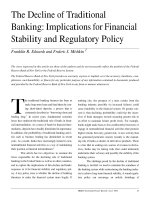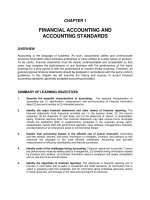Financial Accounting and Its Environment doc
Bạn đang xem bản rút gọn của tài liệu. Xem và tải ngay bản đầy đủ của tài liệu tại đây (672.18 KB, 53 trang )
Financial Accounting
Financial Accounting
and Its Environment
and Its Environment
Chapter 1
Major Types of Accounting
•
Financial accounting provides
information to decision makers who
are external to the business.
–
Examples include present and future
shareholders, present and future
creditors, and government regulators.
Major Types of Accounting
•
Managerial accounting provides
information to decision makers who
are internal to the business.
–
This information is not published to
people outside of the business.
Major Types of Accounting
•
Tax accounting involves tax
compliance and tax planning.
–
Tax compliance involves the calculation
of the company's tax liability after the
transactions for a year have been
completed.
Major Types of Accounting
•
Tax accounting involves tax
compliance and tax planning.
–
Tax planning involves the consideration
of a transaction before it has taken place
in order to determine tax consequences.
Major Types of Accounting
•
Accounting Information Systems
–
The processes and procedures required to
generate accounting information.
Major Types of Accounting
•
Nonbusiness Organization
Accounting
–
Deals with the accounting needs of
organizations which do not attempt to
earn a profit, such as hospitals, colleges,
and churches.
Overview of Financial
Accounting
Financial
Statements
Decision
Makers
Past
Transactions and
Other Economic
Events
Financial
Accounting
Process
The Financial Accounting
Process
•
Categorize past transactions and
events.
•
Measure attributes of those
transactions and events.
•
Record and summarize the
measurements.
The Financial Accounting
Process
•
The initial valuation of a transaction is
generally not changed in the future.
–
This original measurement is called the
historical cost.
Primary Financial
Statements
•
The end result of the accounting
process is the preparation of the
following:
–
Balance sheet
–
Income statement
–
Statement of cash flows
The Balance Sheet
•
The balance sheet shows a firm's
assets, liabilities, and owners' equity
at one point in time.
The Balance Sheet
•
Assets are valuable resources that a
firm owns.
•
Liabilities are obligations to convey
something of value in the future.
The Balance Sheet
•
Owners' equity is a residual amount,
calculated by subtracting liabilities
from assets.
–
If assets are $300 and liabilities are $50,
then owner's equity must equal $250.
The Balance Sheet
Assets Liabilities and Owners’ Equity
Cash 5,000 Liabilities
Accounts receivable 7,000 Accounts payable 8,000
Inventory 10,000 Notes payable 2,000
Equipment 7,000 Total liabilities 10,000
Owners’ equity 19,000
Total assets 29,000
Total liabilities and
owners’ equity 29,000
The Income Statement
•
The income statement summarizes a
firm's revenues and expenses for a
period of time.
The Income Statement
•
Revenues are inflows of assets from
providing goods and services to
customers.
•
Expenses are the costs incurred to
generate revenues.
The Income Statement
•
If revenues exceed expenses, then the
result is net income.
•
If expenses exceed revenues, then the
result is a net loss.
–
If expenses are $500 and revenues are
$400, then there is a net loss of $100.
The Income Statement
Revenues
Sales 63,000
Expenses
Cost of goods sold 35,000
General and administrative 20,000
Tax 3,000
Total expenses 58,000
Net income 5,000
The Statement of Cash
Flows
•
The statement of cash flows
summarizes a firm's inflows and
outflows of cash over a period of time.
The Statement of Cash
Flows
•
The statement has three sections.
–
Operating activities—deal with a
company's operations.
–
Investing activities—deal with a
company's long-term asset transactions.
–
Financing activities—deal with a
company's long-term debt activities and
activities involving shareholders.
The Statement of Cash
Flows
Distinguishing Between
Financial Statements
•
The balance sheet reports its
components as of one moment in time.
•
The income statement and the
statement of cash flows cover a period
of time.
Notes to the Financial
Statements
•
Clarify and expand upon the material
presented in the body of the
statements.
Notes to the Financial
Statements
•
They are an integral part of a set of
financial statements.
–
An example is a note which explains a
company's inventory pricing policies or
the methods used to depreciate fixed
assets.









